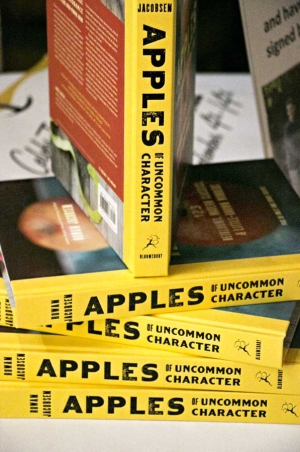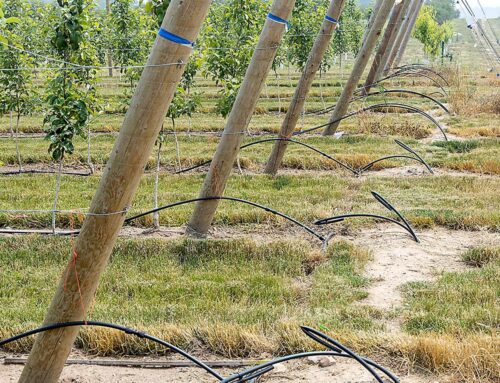
Author Rowan Jacobsen in Yakima, Washington on September 5, 2014. (TJ Mullinax/Good Fruit Grower)
Ten years ago, book editor Rowan Jacobsen and his wife bought an 1840s farmhouse in Vermont that came with four acres of meadows, including apple trees.
Jacobsen grew up eating McIntosh apples, but he found them often mushy and rubber-skinned. He didn’t consider himself an avid apple eater.

A stack of “Apples of Uncommon Character” by Jacobsen are arranged during his book tour visit in Yakima. (TJ Mullinax/Good Fruit Grower)
But as a new owner of apple trees, he found himself intrigued by the unusual fruit growing on his land. The apples were unlike any he had seen or tasted. Some were large, round and red, and striped like beach balls. Others were brown and fuzzy. One tree produced oddly shaped fruit with speckles of red and orange over a background of greens and yellows; Jacobsen took a bite.
“Juice exploded into my mouth, fragrant with cinnamon and spice,” he wrote later. This was not what he expected from an apple. “It was heavenly, and I realized right then and there that I’d been missing out.”
Jacobsen, the author of A Geography of Oysters, began to notice throughout Vermont trees with apples with various tastes, shapes, and colors. His research in Vermont and across America, including central Washington State, led to his latest book, Apples of Uncommon Character.
I met recently with Jacobsen in Yakima, Washington, where trucks in the region had already begun hauling apples to packing houses. Jacobsen, a dark, slender man with a ready smile, is whip smart and good company on many subjects. He’s won numerous awards for writing about food, people, and adventure.
Commercial apple growers know well the transformation of their industry, the explosion of new varieties, and changes in how apples are marketed. Consumers are turning from old reliables such as Red Delicious to brands such as Pink Lady and to varieties such as Honeycrisp. Jacobsen says we have entered a Second Age of the Apple, the first occurring in the early 1700s and lasting until the rise of what he calls industrial-scale orchards.
In the new age, consumers have astonishing choices. “We have more varieties of extraordinary apples within reach—through mail-order suppliers, farmers’ markets, pick-your-own orchards, and enlightened grocers like Whole Foods—than any people who have come before us,” he writes. “Hard cider, too, is in a full-blown renaissance; there simply have never been as many superb ciders in existence, professional and amateur, as there are at this very moment.”
Apples of Uncommon Character is aimed at general readers, but growers too will enjoy Jacobsen’s comments about the apple’s history and enduring appeal. Opinions will differ about his comments on different varieties. His book discusses 123 varieties that are richly illustrated by Seattle photographer Clare Barboza. Images include shots of Harmony Orchards in Tieton, Washington.
Jacobsen is a vivid, witty writer. I love the way he describes taste. Here’s Honeycrisp: “When you bite into a Honeycrisp, one perfect, bite-size chunk cleaves effortless into your mouth with a snap. Sweet juice sprays across your taste buds—an effect of the exceptionally large and turgid cells, which pop like caviar.”
Yum. I especially enjoyed the book’s treatment of what he calls Oddballs, apples of curious character. Jacobsen says when the Knobbed Russet grows right, it looks wrong. It’s supposed to be covered with warts and welts. Yet once the skin is removed, “you discover a sweet, funky, tasty beast, both perfumed and earthy at the same time.”
And what about the most successful apple in the history of the world? That would be Red Delicious.
Jacobsen places the mighty red in the Oddballs section. He doesn’t care much for its flavor. The variety became less flavorful as its skin became redder, he says. Consumers still buy Red Delicious, but Jacobsen attributes that more to habit. It’s a “zombie apple…the life left it long ago. It may still be America’s number one apple … In two decades, it will be as forgotten as Winesap is today—and far less mourned.” Ouch.
Perhaps Jacobsen’s harsh take on Red Delicious should be viewed in the context of his love for all things apple. He says the apple is embedded in our culture. He marvels at the creativity of the apple, almost a shape shifter in its ability to alter its look and taste.
“The apple has one of the largest genomes of any food plant, and it’s full of recessive genes and genetic switches. In every apple seed, the genetic deck is reshuffled, new combinations of genes interact in mysterious ways, and many traits that were invisible in the parent may suddenly turn up in the child, or vice versa.”
On this, Jacobsen certainly has it right. New varieties contribute to dynamism in the fruit industry. This issue of Good Fruit Grower describes excitement around new apples, including the Koru from New Zealand. When I told Jacobsen about the Koru, his ears perked up. He wanted to know more. He and other readers can read about it by clicking here. •






Absolutely the best apple I ever eaten. I am so disappointed that I have been unable to find any more to buy since the first bag I brought! I wish all of the growers the best of luck and look forward to finding these in the stores in the new future.